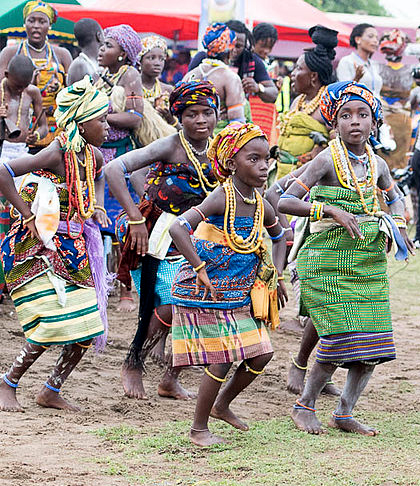AGBADZA - THE DANCE OF ENTERTAINMENT
The dance "Agbadza", is a dance performed by the people of Togo, Benin and the western part of NIgeria. When we come to Ghana, we have the Ewe tribe of the Volta Region performing the "Agbadza" dancee. The dance is not usually performed by the whole tribe of Ewes. We have th Anlo's, who are the patrons of the dance, the Avenors, the Tongu's and some part of th Wedome people performing this dance of "Agbadza."
"Agbadza" has many rhythms likened to it. We have the Misornu, Agee, Awuna, Kinka, Atokoe, Adzida, Adzidasogbo, Atsafu, Atsiagbekore, Madedzi and Atrikpui. All these are rhythms likened to "Agbadza." All these rhythms are performed using the same set of local instruments since without these instruments, the dance cannot be performed to perfection. The instruments include, a set of four drums, a "gakogoe"- which is a two conical metal joined to a tiny rod of metal at the base. The two sides are not of equal length. It makes sound when tapped rhythmically with wooden stick. Another instrument is the "akaya" or "axatsa" which is a dried melon gourd emptied of it seeds and adorned with beads to produce a "tsk, tsk,tsk" sound. The last instrument is the hands. The drums consists of the Gabla - the lead drum and the biggest and the longest followed by the Sogbo - the second biggest, the Asiga - the third big drum and the Asivi - the smallest drum.
THE GABLA, SOGBO, ASIGA AND ASIVI DRUMS 

THE GAKOGUI

THE AKAYA/ AXATSA

"Agbadza" was formerly known purely as "Atrikpui". "Atrikpui" was a dance of the warriors of the Eweland. In the early 1800's, when the Ewes were fighting for land to settle on after fleeing from the feared and wicked ruler Agorkoli, this dance was initiated. It was performed whenever the warriors were going out to war with their enemies for territories. The dance's main motive was to encourage the warriors to go to war and return successfully. This signifies that the people are with them in spirit as they go to war. In the 1920's, the Ewes had conquered every land around them which they needed to settle down on and so there was no need for the warriors to go to war again, they decided to make their dance a dance of entertainment, hence, "Agbadza".
"Agbadza" starts with Banyinyi, which is prayers to the gods and the invocation of the spirits to join in the dance. Then comes Vutsortsor. This is where the Gabla s sounded about three times to signify the start of the dance. The third phase is the Adzotutu, where all the instruments are played together to give the rhythm of the dance. After this comes the fourth stage which is the Hatiatia. this is where the singers lift up one song and sing just 2 or 3 lines then move to the next. in doing so, they are able to get their singing list. the drummers and singers usually sit in a semi circle. The final phase is the second Vutsortsor, where the Gabla sounds very hard and high together with the other instruments and the voice of the singers. The dance has started. The leader for an "Agbadza" troupe is called the Azagunor.
THE AGBADZA DANCE IN PERFORMANCE


The dance is performed with the back, arms and feet and therefore called a chicken dance. if you can imitate a chicken flapping its wings then you can dance Agbadza.


One only needs a one piece colth around his or waist over their clothing to dance "Agbadza". This dance of entertainment is danced in Churches, Weddings, Outdooring, during Funerals, Festivals and even parties. So far as there will be entertainment, "Agbadza" is there to serve.
BY EMELIA NORGBEY


Comments
Post a Comment